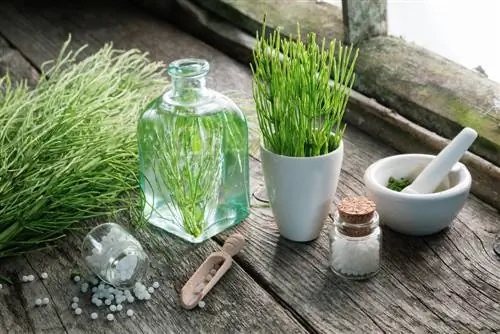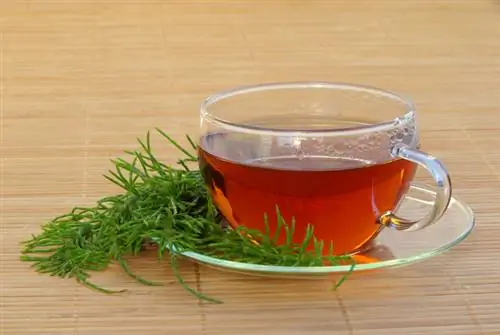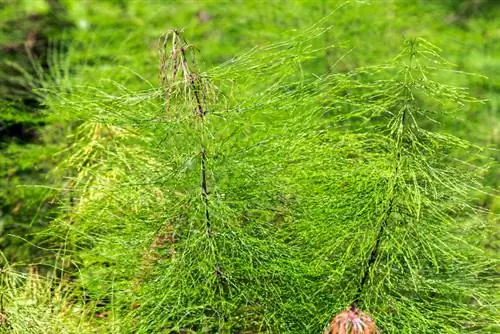- Author admin [email protected].
- Public 2023-12-16 16:46.
- Last modified 2025-01-23 11:22.
Field horsetail was already considered a valuable medicinal plant in ancient times. Horsetail later became particularly important in Sebastian Kneipp's treatments. Proven ingredients such as silica and secondary plant substances can successfully alleviate symptoms, even according to current knowledge.

What effect does field horsetail have?
The effect of field horsetail is based on ingredients such as silica, potassium and secondary plant substances. It can be used for inflammation of the bladder, urinary tract, skin and mucous membranes, for coughs, respiratory problems, bone and joint problems and to strengthen skin, hair and nails.
What ingredients does field horsetail contain?
Field horsetail contains, in addition to mineral components such assilicic acid and potassium, also secondary plant substances Due to its high silica content, the medicinal plant was often used to clean silver in the past and was also called horsetail. Horsetail also contains the trace element potassium. The medicinal plant also produces water-soluble plant pigments, the so-called flavonoids, such as camphor oil and quercentin. Basic nitrogen products, which belong to the group of alkaloids, are also present in small quantities. Minerals and flavonoids are present in both fresh stems and dried powder.
How do these ingredients work?
Silicic acid and potassium in field horsetail support the water balance of the cells andstrengthen the cell structure An oxidation-inhibiting effect has been proven for the flavonoid quercentin in horsetail. The effective free radical scavenger counteracts the development of cancer. Camphor oil is classified as an expectorant, local anesthetic, pain-relieving, circulation-stimulating and diuretic. The oil should not be taken in high doses over a long period of time. Avoid field horsetail if you are pregnant, breastfeeding or have heart or kidney disease.
For which complaints can I use field horsetail?
Due to the different ingredients, field horsetailhelps with many different complaints. The uses of horsetail include:
- Inflammation of the bladder and urinary tract
- Cough and respiratory problems
- Inflammation of the skin, mucous membranes or gums
- Bone and joint problems such as rhema and osteoporosis
- Blood vessel diseases such as varicose veins and arteriosclerosis
- Strengthening and strengthening of skin, hair and fingernails
- Reduction of typical signs of aging such as wrinkles and cellulite
In most cases, field horsetail is made into an infusion and then applied locally as a poultice or sitz bath. For internal applications, it makes sense to prepare it as field horsetail tea.
Tip
The correct processing of field horsetail
Silicic acid is the decisive active ingredient when treating cell properties such as strengthening skin, hair, nails and arteries. This dissolves very slowly in water. Therefore, you should carefully consider the instructions for making field horsetail tea and the long cooking time. Flavonoids, on the other hand, are not temperature-stable indefinitely. That's why a tea for medicinal purposes can be steeped for a maximum of 10 minutes.






